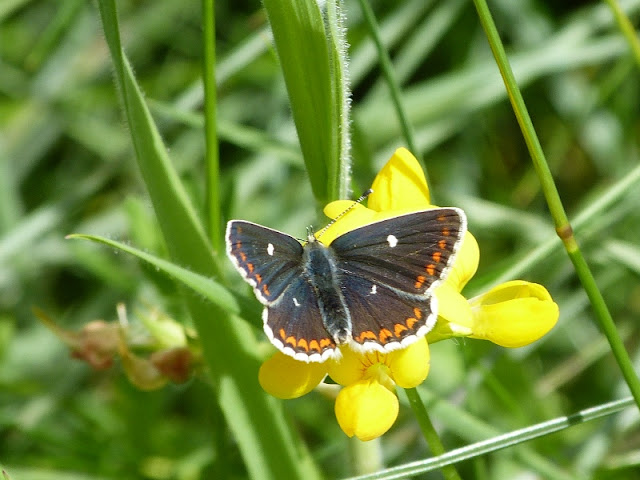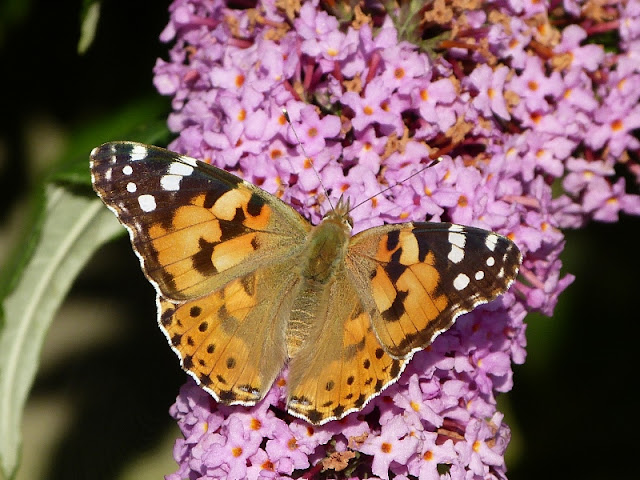Small Copper, Lycaena phlaeas
The Small Copper started the year very well.
The first one was recorded on 17th April and two more were seen the following
day. The first generation did very well and the second generation started
earlier than normal and was seen in good numbers until the middle of August,
when numbers crashed. It seems that the periods of heavy rain knocked numbers
down. The last Small Copper was recorded on 20th September, six weeks earlier
than last year.
As with many other species in 2019 the Wall
Brown appeared early and the spring generation was larger than we would
normally expect. Although the summer generation was larger than the spring
generation, it was closer to the average number that we have seen over the last
few years.
Holly
Blue, Celastrina argiolus
All of these records were from quite public
areas, so I doubt they are the location of the original mystery colony. It will
be really interesting to see how things develop over the next few years.
Green
Hairstreak, Callophrys rubi
The Green Hairstreak is found in a few remote colonies
around East Lothian, mostly in the Lammermuir Hills. Because of this we don't
get many records. The most easily reached site where they are found is Saltoun
Wood, but this colony has suffered a serious decline. There had been a fire
there early last year and this year we only recorded three individuals in that
area. The three records we received were on 30th April, 15th May and 9th June.
Small
Heath, Coenonympha pamphilus
2019 was a good year for Small Heaths. It was
notable hat they did particularly well in the summer generation. The first
record was on 10th May and they were seen through to the 7th September.
Common
Blue, Polyommatus icarus
Common Blue did very well in 2019. The first
record was on 24th May and I received almost double the normal number of
records. As has been noted with other species, it is the year after a good
season that the number of butterflies increases.
Meadow Browns also did very well in 2019. I
was surprised that we didn’t see more in 2018 when we had such good weather,
but I realise that the number we see reflects the weather of the previous year.
The first record in 2019 was on 18th June. They had quite a short season, but
were seen in greater numbers than in the previous six years.
The number of Ringlets recorded in 2019 was
about average, but they were condensed into a shorter season than normal. The
first record was on 18th June and they were initially slow to build up their
numbers. However, they peaked in the middle of July and then quickly dropped
away, with the last record being on the 15th August.
The Small Skipper has been increasing in
number year on year, since it was first discovered in East Lothian in 2011. The
trend continued in 2019 when we received records of 677 skippers, an increase
of over 50% on the previous year. The first record was on 22nd June and they
were seen in great numbers in July. They are also continuing to extend their
range in East Lothian.
Dark Green Fritillaries had an amazing year in
2019 with almost twice the normal number being seen. The first record was on
23rd June and they were recorded until 10th August. Dark Green Fritillaries are
mostly found on coastal sites in East Lothian but can also be found in one or
two remote valleys in the Lammermuir Hills.
Grayling are found in three locations in East
Lothian. One of these is very remote cleugh in the Lammermuirs and I didn't
receive any records from there this year. The other two sites are at Blindwells
and Meadowmill. The Blindwells site is about to be lost to a large housing
development, but thankfully the contractors have fenced off the area where the
Grayling are found. However, this remains a very small area surrounded by earth
moving equipment. Amazingly, on the only occasion anyone was able to visit there,
they recorded 13 Graylings flying. A few hundred yards away at Meadowmill
Graylings were recorded in much greater numbers than in previous years. The
first record was on 26th June and records of over 400 Graylings were received.
Northern Brown Argus, Aricia artaxeres
Northern Brown Argus are only known to exist
in four small colonies in East Lothian. They are all quite remote and isolated,
so take a bit of dedication to get to. Because of this I only received one
record of a Northern Brown Argus on the 20th July. I know they did very well in
the Scottish Borders and I have no reason to believe that they wouldn't have
done well here, too.
I didn't receive any records for Large Skippers in 2019, but I think
they will still be out there along the foothills of the Lammermuirs. Neither
did I receive any records of Small Pearl
Bordered Fritillaries. They are only known from a couple of sites in East
Lothian and we never get records of more than one or two in a good year! Given
the prolonged period of great weather earlier in the summer I was surprised
that we didn't receive any records of Clouded
Yellows or any other unusual migrants.
Once again, I want to send a big thank you to everyone who
sent in their records to me last year. The combined efforts of everyone creates a very good
picture of how butterflies are doing in East Lothian.




















